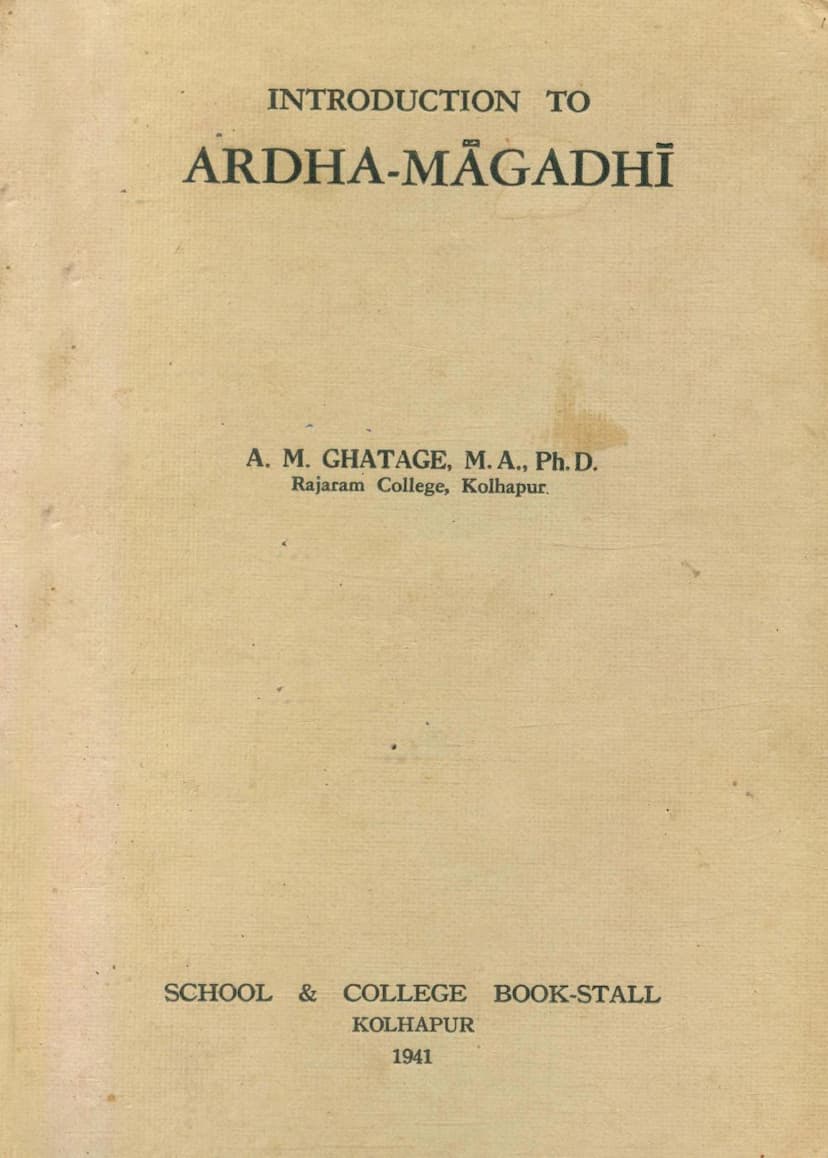Introduction To Ardhamagadhi
Added to library: September 1, 2025

Summary
This document is the "Introduction to Ardha-Magadhi" by A. M. Ghatage, published in Kolhapur in 1941. It is a textbook intended for high school and college students, aiming to provide a comprehensive study of the Ardha-Magadhi language, a Prakrit dialect significant for its use in Jain religious texts.
The book is structured into three parts:
Part I: Phonology This part systematically covers the sound system of Ardha-Magadhi.
- Chapter One: Alphabet, Sounds and Vocabulary: Introduces the alphabet, pronunciation, orthography, syllable structure, quantity, stress, punctuation, and vocabulary. It highlights the distinction between Sanskrit-derived words (tatsama, tadbhava) and native words (desi).
- Chapter Two: Single Consonants: Details the changes in initial, medial, and final single consonants when words transition from Sanskrit to Ardha-Magadhi. It covers phenomena like dropping, voicing, aspiration, changes in the place of articulation, and other sporadic changes.
- Chapter Three: Conjunct Consonants: Explains how consonant clusters are handled, including assimilation, doubling, dropping of members, and specific changes involving mutes, nasals, semi-vowels, liquids, and sibilants. It also covers more complex groups of three consonants and initial conjuncts.
- Chapter Four: Sonants, Vowels and Visarga: Discusses the changes related to Sanskrit sonants (like 'r'), vowels (including the loss of diphthongs and the development of new short vowels), and the visarga ('h').
- Chapter Five: Other Phonetic Changes: Covers phenomena such as anaptyxis (insertion of vowels to break up clusters), compensatory lengthening, spontaneous nasalisation, prothesis (insertion of sounds at the beginning of words), effects of accent, syncope (loss of syllables), haplology (loss of a syllable due to similarity), metathesis (transposition of sounds), and samprasārana (the change of semi-vowels into vowels).
- Chapter Six: Sandhi: Examines the rules of sound combination at word boundaries, both vowel and consonantal sandhi, noting that Ardha-Magadhi is less strict than Sanskrit in observing these rules.
Part II: Morphology This part focuses on the grammatical forms and their usages.
- Lessons One to Fifteen: Systematically cover various aspects of grammar, including:
- Gender and Number: Ardha-Magadhi retains three genders (masculine, feminine, neuter) and two numbers (singular, plural), with the loss of the Sanskrit dual.
- Cases: It outlines six cases (Nominative, Accusative, Instrumental, Ablative, Genitive, Locative) and the Vocative, explaining their meanings and usages, with the Dative function largely absorbed by the Genitive.
- Noun Declension: Details the declension of masculine, feminine, and neuter nouns based on their stem endings (-a, -i, -u, -ā, etc.), including historical origins and additional forms. It also covers irregular declensions of certain noun types.
- Pronouns: Explains the declension and usage of personal, demonstrative (tat, etad, idam, adas), and interrogative pronouns.
- Verb Conjugation: Discusses the tenses (Present, Past, Future), moods (Imperative, Potential), and voices (Active, Passive). It categorizes roots into three classes and details the formation of present bases, past tenses (aorist, imperfect, perfect), future tenses, imperative, potential, and passive forms. It also covers the formation and usage of participles (present active, past passive, potential passive) and gerunds.
- Causal and Intensive Forms: Explains how these forms are derived and used.
- Numerals: Covers cardinal, ordinal, and other types of numerals, their declension, and usage.
- Adverbs, Prepositions, Conjunctions: Details their formation, usage, and origin.
Part III: Syntax and Compounds This section addresses how words are combined into phrases and sentences, and the structure of compounds.
- Article: Notes the absence of explicit articles and how definite and indefinite meanings are conveyed.
- Agreement: Explains the agreement in gender, number, case, and person between various sentence elements (subject-verb, substantive-adjective, pronoun-antecedent, numerals).
- Number: Discusses the singular, plural, and the loss of the dual.
- Cases: Provides a detailed analysis of the various uses and meanings of each case, including instrumental of means, motive, and time; dative of purpose and advantage; ablative of origin, comparison, and with specific verbs/nouns; genitive of possession, subject, object, partitive, origin, and with verbs/adjectives; locative of place and time; and its use in absolute constructions.
- Pronouns: Further details the usage of personal, demonstrative, interrogative, and relative pronouns.
- Tenses and Moods: Elaborates on the usage of the present (as historical present, expressing continuous or habitual action, immediate future), past (primarily replacing Sanskrit tenses with the participle), and future (expressing future action, uncertainty, exhortation, condition). It also covers the imperative and potential moods, and their nuances.
- Participles and Gerunds: Explains their formation and extensive use in conveying past actions, subordinate clauses, conditional ideas, and even finite verb functions.
- Infinitive: Discusses its formation and purpose, noting its function similar to the gerund in some cases.
- Phrase: Analyzes sentence construction, including co-ordination (asyndetic and syndetic) and subordination, the role of conjunctions and relative pronouns, and the expression of comparison and condition.
- Word Order: Outlines the general tendencies of word order in Ardha-Magadhi prose, emphasizing the subject-verb structure, and how emphasis can alter this order. It discusses the placement of adjectives, appositives, pronouns, vocatives, objects, instruments, and verb prefixes.
- Compounds: Classifies compounds based on Sanskrit models into Dvandva (copulative), Tatpurușa (determinative), Bahuvrīhi (possessive), and Avyayībhāva (adverbial), detailing their formation, subdivisions, and numerous examples.
The book concludes with appendices providing a grammatical summary, glossaries (Ardha-Magadhi to English and English to Ardha-Magadhi), and an explanatory index. It acknowledges the author's teachers and the publisher for their contributions. The preface highlights the book's intended audience and its pedagogical approach, including the use of transliteration and distinguishing between material for elementary students and those interested in linguistics. It also notes that the work is largely a compilation based on previous studies of Prakrit and Sanskrit grammar, while incorporating some new matter and a specific arrangement.